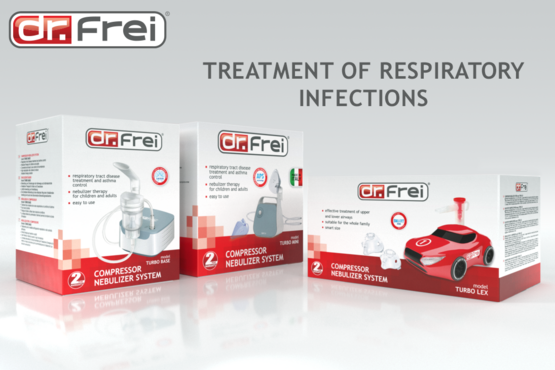Five Things Everyone Should Know about Inhalers
A modern strategy for the treatment of respiratory diseases is associated with the widespread use of inhaled forms of medicinal products.
First of all, this is the possibility of direct and quick action on the inflamed areas in the mucous membranes. Secondly, the inhaled substance is practically not absorbed into the bloodstream and does not have side effects on other organs and systems, as in the case of taking pills or injections.
The potential of nebulizers has impressively expanded the scope of inhalation therapy. Now it has become available to patients of all ages. Dr. Frei, an innovator in the home medical device industry, offers a wide range of nebulizers, including designs specifically focused on children.
1. So, what does aerosol therapy mean, and what is the purpose of aerosols?
Artificial aerosol therapy is useful in treating upper respiratory tract infections, especially in young children. An aerosol unit is used to convert a liquid medication into vapors, which go directly to the site of inflammation, that is, into the respiratory tract, when inhaled through a mask or mouthpiece. Doctors strongly recommend keeping inhalers in every family owing to a number of indications for use. Medications used for nebulization are usually mixed with the saline and should always be taken as directed by a physician, both in terms of dosage and combinations.
2. Benefits of nebulizer therapy
Nebulizer therapy allows quickly affecting the area of inflammation by high doses of the medication, which increases the efficiency of treatment and reduces the risk of side effects on other organs. Nebulizer therapy is the most economically viable treatment method in terms of targeted consumption of the medication, and it is widely used for children, elderly people, and debilitated patients. The international programs identify the following factors of key success of the inhalation therapy:
• availability of the effective and safe medication;
• inhalation unit which provides a fraction of the inhaled medication;
• correct inhalation technique.
3. What are Turbo Lex, Turbo Base, Turbo Mini and how do they work?
Compressor nebulizer is a device converting the liquid medication into finely dispersed aerosol under action of compressed air. Aerosol contains large and small particles. In the process of breathing, large particles under action of gravity settle on the walls of the upper respiratory tract, while small particles have time to reach the lower bronchi. Therefore, the medication enters all the parts of the bronchial tree, including the smallest bronchi and alveoli, and penetrates the blood vessels in the alveoli walls in high therapeutic doses with little or no side effects.
The technology for particle size control, implemented in Dr. Frei Turbo Mini nebulizer, allows generating aerosols with different particle sizes for effective treatment of the upper and lower respiratory tract. Particle size can be easily controlled by the user without replacement of the component parts. For treatment of the upper respiratory tract (oropharynx, larynx, and trachea), turn the medication bottle cap to MAX (II) mark. In this position, the size of generated aerosol particles will make 6 microns (MMAD).
Dr. Frei Turbo Base nebulizer has a high rate of atomization, which helps to deliver medicine in a short time directly to the area of inflammation.
Dr. Frei Turbo Lex nebulizer features design focused on children, but with the efficiency appreciated by adults; nebulizer is the best assistant in the fight against colds, laryngitis, and runny nose.
4. When to use nebulizer therapy?
Nebulizer therapy is used in acute respiratory diseases; obstructive pulmonary diseases; chronic inflammatory processes of the respiratory tract, such as chronic bronchitis, bronchial asthma (including chronic, unstable, acutely exacerbated BA), chronic pharyngitis; respiratory tract infections; violation of quality of mucus and its secretion in bronchi; various types of coughs.
5. Rules to be followed in the process of inhalation:
• Duration of the inhalation procedure is max. 5-7 minutes in children and 10-15 minutes in adults;
• Up to 3 inhalations per day are recommended;
• Herbal oils and teas are contraindicated for inhalation procedures;
• Inhalations are contraindicated in case of fever or blood streaked sputum;
• If inhalation procedure is carried out in two patients simultaneously, a pause of 20 minutes is required;
• For inhalations, use only the medications recommended or prescribed by your doctor;
• Component parts should be disinfected after each inhalation;
• Inhalation should be carried out one hour before eating, sleeping, or walking.
Consequently, nebulizer reduces the risk of side effects compared to taking the same medications orally. Use of the nebulizer can decrease the number of emergency department visits and hospitalizations required for a patient, which also results in lower costs. Wide range of nebulizers of high quality can be found in city stores and pharmacies and on the website dr-frei.com.
We promise to send you only good news
